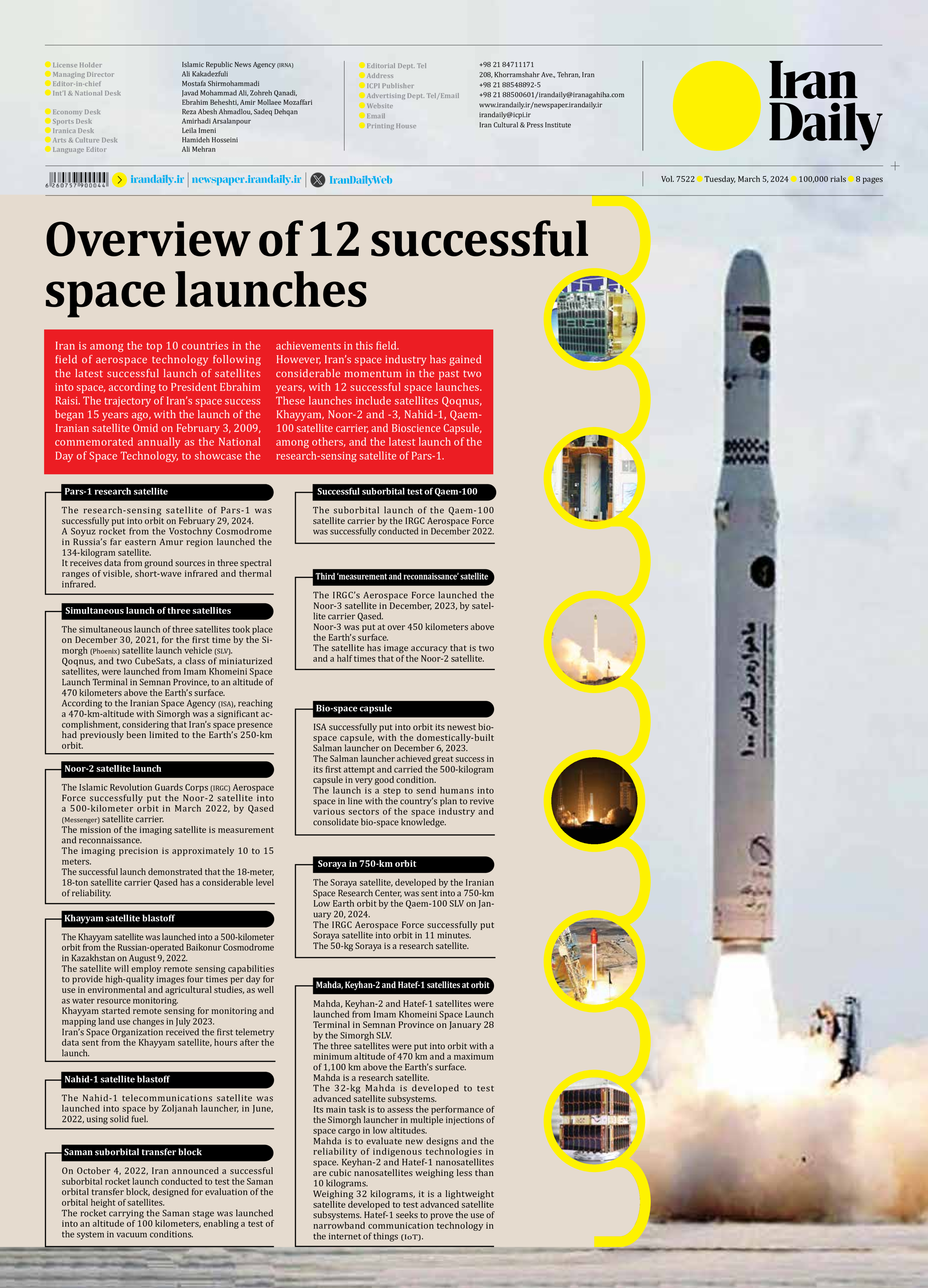
Overview of 12 successful space launches
Iran is among the top 10 countries in the field of aerospace technology following the latest successful launch of satellites into space, according to President Ebrahim Raisi. The trajectory of Iran’s space success began 15 years ago, with the launch of the Iranian satellite Omid on February 3, 2009, commemorated annually as the National Day of Space Technology, to showcase the achievements in this field.
However, Iran’s space industry has gained considerable momentum in the past two years, with 12 successful space launches. These launches include satellites Qoqnus, Khayyam, Noor-2 and -3, Nahid-1, Qaem-100 satellite carrier, and Bioscience Capsule, among others, and the latest launch of the research-sensing satellite of Pars-1.
Pars-1 research satellite
The research-sensing satellite of Pars-1 was successfully put into orbit on February 29, 2024.
A Soyuz rocket from the Vostochny Cosmodrome in Russia’s far eastern Amur region launched the 134-kilogram satellite.
It receives data from ground sources in three spectral ranges of visible, short-wave infrared and thermal infrared.
Simultaneous launch of three satellites
The simultaneous launch of three satellites took place on December 30, 2021, for the first time by the Simorgh (Phoenix) satellite launch vehicle (SLV).
Qoqnus, and two CubeSats, a class of miniaturized satellites, were launched from Imam Khomeini Space Launch Terminal in Semnan Province, to an altitude of 470 kilometers above the Earth’s surface.
According to the Iranian Space Agency (ISA), reaching a 470-km-altitude with Simorgh was a significant accomplishment, considering that Iran’s space presence had previously been limited to the Earth’s 250-km orbit.
Noor-2 satellite launch
The Islamic Revolution Guards Corps (IRGC) Aerospace Force successfully put the Noor-2 satellite into a 500-kilometer orbit in March 2022, by Qased (Messenger) satellite carrier.
The mission of the imaging satellite is measurement and reconnaissance.
The imaging precision is approximately 10 to 15 meters.
The successful launch demonstrated that the 18-meter, 18-ton satellite carrier Qased has a considerable level of reliability.
Khayyam satellite blastoff
The Khayyam satellite was launched into a 500-kilometer orbit from the Russian-operated Baikonur Cosmodrome in Kazakhstan on August 9, 2022.
The satellite will employ remote sensing capabilities to provide high-quality images four times per day for use in environmental and agricultural studies, as well as water resource monitoring.
Khayyam started remote sensing for monitoring and mapping land use changes in July 2023.
Iran’s Space Organization received the first telemetry data sent from the Khayyam satellite, hours after the launch.
Nahid-1 satellite blastoff
The Nahid-1 telecommunications satellite was launched into space by Zoljanah launcher, in June, 2022, using solid fuel.
Saman suborbital transfer block
On October 4, 2022, Iran announced a successful
suborbital rocket launch conducted to test the Saman orbital transfer block, designed for evaluation of the orbital height of satellites.
The rocket carrying the Saman stage was launched into an altitude of 100 kilometers, enabling a test of the system in vacuum conditions.
Successful suborbital test of Qaem-100
The suborbital launch of the Qaem-100 satellite carrier by the IRGC Aerospace Force was successfully conducted in December 2022.
Third ‘measurement and reconnaissance’ satellite
The IRGC’s Aerospace Force launched the Noor-3 satellite in December, 2023, by satellite carrier Qased.
Noor-3 was put at over 450 kilometers above the Earth’s surface.
The satellite has image accuracy that is two and a half times that of the Noor-2 satellite.
Bio-space capsule
ISA successfully put into orbit its newest bio-space capsule, with the domestically-built Salman launcher on December 6, 2023.
The Salman launcher achieved great success in its first attempt and carried the 500-kilogram capsule in very good condition.
The launch is a step to send humans into space in line with the country’s plan to revive various sectors of the space industry and consolidate bio-space knowledge.
Soraya in 750-km orbit
The Soraya satellite, developed by the Iranian Space Research Center, was sent into a 750-km Low Earth orbit by the Qaem-100 SLV on January 20, 2024.
The IRGC Aerospace Force successfully put Soraya satellite into orbit in 11 minutes.
The 50-kg Soraya is a research satellite.
Mahda, Keyhan-2 and Hatef-1 satellites at orbit
Mahda, Keyhan-2 and Hatef-1 satellites were launched from Imam Khomeini Space Launch Terminal in Semnan Province on January 28 by the Simorgh SLV.
The three satellites were put into orbit with a minimum altitude of 470 km and a maximum of 1,100 km above the Earth’s surface.
Mahda is a research satellite.
The 32-kg Mahda is developed to test advanced satellite subsystems.
Its main task is to assess the performance of the Simorgh launcher in multiple injections of space cargo in low altitudes.
Mahda is to evaluate new designs and the reliability of indigenous technologies in space. Keyhan-2 and Hatef-1 nanosatellites are cubic nanosatellites weighing less than 10 kilograms.
Weighing 32 kilograms, it is a lightweight satellite developed to test advanced satellite subsystems. Hatef-1 seeks to prove the use of narrowband communication technology in the internet of things (IoT).







